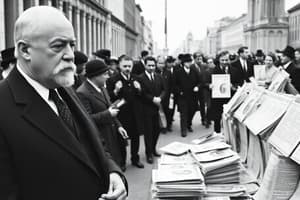Podcast
Questions and Answers
What was the primary goal of Stresemann's diplomacy?
What was the primary goal of Stresemann's diplomacy?
- To improve Germany's position through negotiation and agreement (correct)
- To prepare Germany for another war.
- To isolate Germany from the rest of Europe.
- To undermine the Treaty of Versailles through military force.
The League of Nations was founded as part of the Treaty of Versailles to prevent future wars, and the USA was a leading member.
The League of Nations was founded as part of the Treaty of Versailles to prevent future wars, and the USA was a leading member.
False (B)
What period is often referred to as the 'Golden Years of the Weimar Republic' or the 'Stresemann Era'?
What period is often referred to as the 'Golden Years of the Weimar Republic' or the 'Stresemann Era'?
1924-1929
In August 1923, Stresemann was appointed Chancellor by President ________.
In August 1923, Stresemann was appointed Chancellor by President ________.
Match the currency with its description during Stresemann's economic policies:
Match the currency with its description during Stresemann's economic policies:
What promise was made regarding the Rentenmark to encourage trust in the new currency?
What promise was made regarding the Rentenmark to encourage trust in the new currency?
The introduction of the Rentenmark fully resolved all economic divisions and made everyone happy.
The introduction of the Rentenmark fully resolved all economic divisions and made everyone happy.
What was the primary issue Stresemann aimed to resolve regarding reparations?
What was the primary issue Stresemann aimed to resolve regarding reparations?
The Dawes Plan involved Germany receiving loans primarily from ________.
The Dawes Plan involved Germany receiving loans primarily from ________.
Match the effect to the correct plan:
Match the effect to the correct plan:
What was a negative aspect of the Dawes Plan?
What was a negative aspect of the Dawes Plan?
The Young Plan increased Germany's reparation payments.
The Young Plan increased Germany's reparation payments.
What was one criticism of Stresemann's economic policies from right-wing groups regarding the Young Plan?
What was one criticism of Stresemann's economic policies from right-wing groups regarding the Young Plan?
In 1925, Stresemann signed the ________ Pact with Britain, France, Italy, and Belgium.
In 1925, Stresemann signed the ________ Pact with Britain, France, Italy, and Belgium.
Match the terms of the Locarno Pact with their implications:
Match the terms of the Locarno Pact with their implications:
What was a significant outcome for Stresemann in 1926, relating to his efforts in international relations?
What was a significant outcome for Stresemann in 1926, relating to his efforts in international relations?
Germany was never considered a 'Great Power' again after World War I.
Germany was never considered a 'Great Power' again after World War I.
What international body did Germany join in 1926, signifying its re-acceptance into the global community?
What international body did Germany join in 1926, signifying its re-acceptance into the global community?
The Kellogg-Briand Pact, signed by Germany and 61 other countries, promised not to use ________ to solve problems.
The Kellogg-Briand Pact, signed by Germany and 61 other countries, promised not to use ________ to solve problems.
Match the Treaty or Pact with its significance for Weimar Germany:
Match the Treaty or Pact with its significance for Weimar Germany:
What concern did Stresemann express shortly before his death regarding Germany's economic stability?
What concern did Stresemann express shortly before his death regarding Germany's economic stability?
The Weimar Republic had no opposition and was unanimously supported by all Germans by 1929.
The Weimar Republic had no opposition and was unanimously supported by all Germans by 1929.
Identify one factor that suggests Germany's economic recovery was not as robust as it appeared.
Identify one factor that suggests Germany's economic recovery was not as robust as it appeared.
According to a German foreign policy critic, Stresemann was a _______ for cooperating with France and Britain.
According to a German foreign policy critic, Stresemann was a _______ for cooperating with France and Britain.
What was the initial position of Stresemann regarding the Weimar Republic before becoming its Chancellor?
What was the initial position of Stresemann regarding the Weimar Republic before becoming its Chancellor?
Flashcards
Diplomacy
Diplomacy
The use of negotiations and agreements to reach decisions and resolve differences between countries.
League of Nations
League of Nations
International organisation set up as part of the Treaty of Versailles to prevent future wars.
Golden Years of the Weimar Republic
Golden Years of the Weimar Republic
The years 1924-1929 are known as the 'Golden Years of the Weimar Republic' or the 'Stresemann Era'.
Gustav Stresemann
Gustav Stresemann
Signup and view all the flashcards
Rentenmark
Rentenmark
Signup and view all the flashcards
Reichsmark
Reichsmark
Signup and view all the flashcards
The Dawes Plan
The Dawes Plan
Signup and view all the flashcards
The Young Plan
The Young Plan
Signup and view all the flashcards
The Locarno Pact, 1925
The Locarno Pact, 1925
Signup and view all the flashcards
League of Nations, 1926
League of Nations, 1926
Signup and view all the flashcards
Kellogg-Briand Pact 1928
Kellogg-Briand Pact 1928
Signup and view all the flashcards
Extract A: From Weimar and Nazi Germany, F Reynolds, Published in 1996
Extract A: From Weimar and Nazi Germany, F Reynolds, Published in 1996
Signup and view all the flashcards
Study Notes
Recovery of Germany, 1924-1929
- This lesson discusses how Gustav Stresemann attempted to solve Germany's economic and political problems.
Key Terms
- Diplomacy is the use of negotiations and agreements to reach decisions and resolve differences between countries
- The League of Nations was an international organization set up as part of the Treaty of Versailles, intended to prevent future wars.
- It was originally the idea of Woodrow Wilson.
- It was unpopular in the US, so America did not join.
- Defeated countries of WW1 were not allowed to join.
Germany 1924-1929: From Crisis to Stability and Prosperity
- The years 1919-1923 were a time of turmoil.
- The young Republic faced the impact of defeat in WW1, the Treaty of Versailles, revolts, and political assassinations.
- Throughout 1923, Germany was in crisis because of the French occupation of the Ruhr and hyperinflation.
- The Weimar Republic overcame its economic problems, social unrest, and political revolts and entered an age of stability and prosperity within the next few years.
- The years 1924-1929 are known as the 'Golden Years of the Weimar Republic' or the 'Stresemann Era' because of the improvements brought about by Stresemann.
Gustav Stresemann
- Stresemann was the leader of the DVP (The German People's Party - moderate right).
- President Ebert appointed Stresemann as Chancellor in August 1923.
- He had initially opposed the Weimar Republic, but changed his mind when he realized that the alternative was anarchy.
- He was Chancellor for only four months but remained the most influential politician in Germany until his death in 1929, serving as foreign minister.
- In 1923, Stresemann faced challenges like strained relations with other countries, French and Belgian troops occupying the Ruhr, and the German economy crippled by hyperinflation.
- By 1929, Stresemann had improved political stability, contributed to economic recovery, and improved relations with other countries.
Economic Recovery: Hyperinflation
- Due to hyperinflation, the German mark was worthless, so Stresemann needed to stabilize the economy.
- Stresemann abolished the old currency and replaced it with the Rentenmark.
- A new temporary currency with the amount of printed money tightly controlled.
- The new notes were trusted because the government promised to exchange them for shares in German land or industry if the currency failed, which generated confidence in the German economy.
- Stresemann also called off the passive resistance in the Ruhr.
- In 1924, Stresemann replaced the Rentenmark with a new permanent currency.
- The Reichsmark, controlled by an independent national bank, the Reichsbank.
Effects of the New Currency
- Positive:
- Stabilized the economy.
- People trusted it.
- Stopped hyperinflation, and prices dropped.
- People from abroad invested in Germany.
- Improved German business and the employment rate.
- Negative:
- Did not remedy all divisions, and some people were still unhappy.
- Those affected by hyperinflation were never compensated.
- The middle classes were angry as they lost the most.
Reparations
- Stresemann worked on reparations, which were so high that Germany could not pay.
- Believed that Germany would never recover unless this issue was solved.
- Stresemann argued that Germany should accept the Treaty of Versailles to improve foreign relations with Britain and France.
- VERY unpopular with many Germans.
- Stresemann believed that with better relations, it would be possible to negotiate better terms on the reparations.
- Britain and France had a lot to gain from allowing the German economy to recover.
- The USA had lent millions of dollars to France and Britain during WW1.
- If the German economy improved, Germany would make its reparations payments, which would provide Britain and France with the money they needed to repay the USA.
The Dawes Plan
- In 1924, Germany, the USA, Britain, and France agreed to the Dawes Plan.
- Germany was loaned 800 million marks from America.
- This gave a boost to German industry.
- Annual reparation payments were lowered.
- The Allies agreed to review the payments rate over time, considering Germany's ability to pay.
- The French agreed to withdraw troops from the Ruhr.
- Any missing payments in the future would be dealt with by the Allies together.
- Germany received more than 25 billion marks in loans from the USA over the next 6 years.
Effects of the Dawes Plan
- Positive:
- Sparked the recovery of the German economy.
- The French agreed to leave the Ruhr.
- The industrial output doubled between 1923-28.
- Wages rose, the cost of living went down, and the standard of living improved.
- The government built roads, schools, and public buildings.
- Relations with other countries improved, and other countries began to trust Germany.
- Negative:
- Increased resentment from the extreme right-wing parties.
- Extreme political parties found it unacceptable that Germany had agreed to pay reparations again.
- They felt Germany accepted blame for starting the war.
- The economy became fully dependent on American loans. If something went wrong with the American economy, then Germany would be in serious trouble.
The Young Plan, 1929
- Despite the Dawes Plan and American loans, the German government struggled to make reparation payments.
- The Young Plan was agreed to in 1929.
- The reparations were reduced from £6.6 billion to £2 billion.
- Germany was given 59 more years to pay in small installments.
Effects of the Young Plan
- Negative:
- Increased resentment from right-wing groups.
- Extreme parties were angry about stretching the payments over more time.
- Adolf Hitler (Leader of the Nazi Party) said they were 'Passing on the penalty to the unborn.'
- Positive:
- Contributed to economic recovery.
- Lower reparations payments meant that the government could lower taxes.
- Lower taxes would mean that the government could spend more on the industry and economic growth.
Stresemann Abroad: Improving Relations
- Stresemann aimed to strengthen Germany's power and wealth through diplomacy.
- He improved Germany's relationship with other countries, including Britain and France, by ending passive resistance in the Ruhr in 1923
The Locarno Pact, 1925
- In 1925, Stresemann signed the Locarno Pact with Britain France, Italy, and Belgium.
- It was written ON EQUAL TERMS (Unlike the T.O.V)
- Germany accepted new 1919 western borders with France (not eastern ones).
- Germany agreed that Alsace Lorraine would be French, and in return, the French agreed not to occupy the Ruhr again.
- All countries agreed to avoid using military force except in self-defense.
- The Rhineland would be free from all allied troops by 1930.
- The five powers opened talks about German membership of the League of Nations.
Effects of the Locarno Pact, 1925
- Positive:
- Improved Germany's relations with other countries.
- The Pact reassured France about its borders and Germany about any French invasion/occupation.
- War was less likely.
- Stresemann was given the Nobel Peace Prize in 1926.
- Negative:
- Increased resentment from right-wing groups.
- Some parties disagreed and hated that the Versailles agreements were put in place.
- Extreme parties hated that the Weimar was working with the enemy.
The League of Nations, 1926
- Germany joined the League of Nations in 1926.
- Germany joined the international body in which powerful countries discussed solving the world's problems to solve them without going to war.
- Germany was given a place on the League of Nation's Council, which members made the most important decisions, and Germany was once again regarded as a 'Great Power.'
Effects of Germany's Acceptance into the League
- Positive:
- Increased confidence that people had in the Weimar Government.
- Boosted the confidence of Germans in the Weimar.
- Germany was once more accepted into the 'international family.'
- Germany got equal power to 'veto (disagree)' with other countries about certain topics.
- Negative:
- Increased resentment from right-wing groups.
- Not all political parties liked it, some say it was a symbol of the hated T.O.V.
The Kellogg-Briand Pact, 1928
- Germany and 61 other countries signed it.
- It promised not to use war to solve problems.
The Effects of The Kellogg-Briand Pact, 1928
- Positive:
- Increased the confidence that those people had in the Weimar Government.
- Showed that Germany was a part of a new wave of solutions.
- The Weimar continued to grow in support.
- Negative:
- Increased resentment from right-wing groups.
- This treaty did nothing to end/alter the hated Treaty of Versailles.
Studying That Suits You
Use AI to generate personalized quizzes and flashcards to suit your learning preferences.




